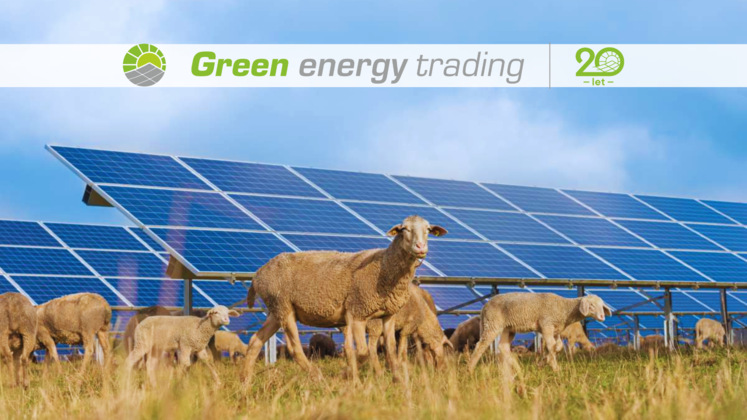Агроволтаика в практиката: слънчево пасищно отглеждане
 17. 7. 2025
17. 7. 2025
What is solar grazing?
Simply put, solar grazing is a practice in which grazing animals are placed in the same field as solar panels. Sheep are most commonly used for this purpose, but other farm animals are also used in some installations.
When installing solar panels, it is advantageous to have a grassy area underneath them. Vegetation prevents rainwater runoff and corrosion, which pollute water sources, but it also needs to be controlled.
Tall vegetation could start to shade the panels and reduce their efficiency. However, the potential fire hazard posed by acres of dry grass is a greater concern.
Solar farm owners have traditionally dealt with this by mowing the grass regularly, but it is difficult to manoeuvre a mower around the poles and panels.
However, sheep are much better ‘natural mowers’ that can fit into small gaps and graze regardless of the weather.
The American Solar Grazing Association estimates that there are currently approximately 80,000 sheep grazing on more than 40,000 hectares at 500 solar farms in 27 US states. This number represents a tenfold increase in just two years.
Examples of solar grazing in Europe
While the US may be heralding a new era in agriculture, Europe has been exploring this for some time.
In 2023, Iberdrola announced that it was keeping a herd of 300 sheep at its photovoltaic parks in Portugal.
Solar grazing is good for solar farms because it ensures ecological land maintenance and reduces the risk of fires, but it also benefits the animals, which, in addition to access to food, find protection from the sun, rain and wind in the solar panels.
In the United Kingdom, a 1 GW project in Nottinghamshire will share its 1,600 hectares with a herd of 4,000 sheep. This number is expected to rise to 9,000 once the lambing season begins, and the project is expected to save £5 million (€5.9 million) in grass cutting costs over its 40-year lifetime.
Since 2016, Enel Power has been using sheep to maintain vegetation at its solar power plants in Greece. And since 2015, a solar farm in Saint-Amadou in the Occitanie region of France has been home to hundreds of sheep.
Sheep and solar panels: a symbiotic relationship
Grazing sheep under solar panels is beneficial not only for the solar farm, but also for the sheep.
Research published in the journal Applied Animal Behaviour Science in 2022 found that sheep with access to solar panels spend more time grazing than sheep without access.
Scientists believe that one reason for this is that the panels provide shade for the sheep.
In a separate report from 2018, it was found that the shade provided by the panels also increases soil moisture. This is aided by condensation and rainwater runoff, which creates better grazing with a high protein content.
The sheep move around the pasture, pressing old plant debris into the soil, fertilising and rejuvenating it. In addition to improving pasture quality, this has been shown to improve soil health and increase carbon and nutrient storage in the long term.
SolarPower Europe has found that pastures under solar panels accumulate up to 80% more carbon. Water retention has increased by 20 to 30%, and the company has seen a 60% increase in pollinators.
Solar grazing brings triple profits to farmers
Farmers around the world are facing financial challenges due to a combination of climate change, rising costs and unstable markets for their products. Expanding into solar grazing can bring benefits on several fronts.
First, there is the contract with the solar farm provider. The amount of income will depend on the location and size of the land they lease.
Instead of closing their fields and having nothing to do with them, farmers have the opportunity to earn a new source of income through solar grazing.
In this way, they earn income from ‘renting’ sheep and provide employment for shepherds. Research by Cornell University has suggested that a farmer can earn between $300 and $500 (€288 to €480) per acre (0.4 hectares) per year for vegetation management using sheep.
Studies show that sheep fed on solar energy are often healthier and have higher production, leading to higher sales of meat and wool from the farm.
A recent study by Josh Pearce on the income potential of solar grazing found that these business models have the potential for ‘huge profits.’
However, some complications need to be considered, such as drinking water for the sheep.
Profits can quickly disappear if sheep are attacked by predators or succumb to parasites or disease, and grazing must be managed with mobile fences to effectively control vegetation.
Nevertheless, the potential of solar grazing to make a significant contribution to carbon emission reduction efforts is clear.
